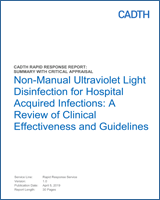| Brite et al., 201817 |
|---|
Post-intervention (PX-UV) versus pre-intervention in a bone marrow transplant unit
Length of hospital stay (median, SD): 29.48 (16.41) versus 24.33 (12.59) days Monthly incidence rate of infection
- –
C. difficile: 9.3 per 1,000 patient days versus 7.1 per 1,000 patient days; P = 0.503 - –
VRE: 12.2 per 1,000 patient days versus 9.7 per 1,000 patient days; P = 0.4389
Interrupted time series analysis Level change after UV cleaning
- –
C. difficile: IRR (95% CI) = 0.51 (0.13 to 2.11); P = 0.356 - –
VRE: IRR (95% CI) = 1.34 (0.37 to 4.80); P = 0.652
Trend change after UV cleaning
- –
C. difficile: IRR (95% CI) = 1.08 (0.89 to 1.31); P = 0.413 - –
VRE: IRR (95% CI) = 0.96 (0.81 to 1.14); P = 0.625
Hospital-acquired incidence rate of infectiony
- –
C. difficile: 1.411 per 1,000 days versus 1.114 per 1,000 days; P = 0.70 - –
VRE: 3.0236 per 1,000 days versus 3.6588 per 1,000 days; P = 0.60
Manual cleaning, hand hygiene compliance, antibiotic utilization: no difference between two periods
| “Utilization of UV disinfection to supplement routine terminal cleaning of rooms was not effective in reducing hospital acquired VRE and C. difficile among stem cell transplant recipients”17 p.1301 |
| Pavia et al., 201818 |
|---|
Post-intervention (UV-C) versus pre-intervention in a pediatric long-term care facility
Hospital acquired viral infections
| “The results suggest that UV-C technology is a potentially important component of eliminating the environment as a source of viral infections”18 p.720 |
| Raggi et al., 201819 |
|---|
Post-intervention (UV-C) versus pre-intervention at a community hospital
Overall HAI incidence rates (per 1,000 patient days): 3.94 versus 4.87; P = 0.006 HAI incidence rates with MDRO (per 1,000 patient days)
- –
Acinetobacter baumannii: 0.16 versus 0.34; P = 0.03 - –
Klebsiella pneumonia: 1.22 versus 1.16; P = 0.36 - –
MRSA: 0.98 versus 1.42; P = 0.02 - –
Pseudomonas aeruginosa: 1.16 versus 1.29; P = 0.22 - –
VRE: 0.45 versus 0.68; P = 0.05
Emergency department admissions: 297.9 minutes versus 296.2 minutes; P = 0.18 Direct cost saving: $1,219,878 over a 12-month period calculated from the reduction of hospital length of stay
| “The UV-C disinfection was associated with a statistically significant facility-wide reduction of multidrug-resistant HAIs and generated substantial direct cost savings without adversely impacting hospital operations”19 p.1224 |
| Sampathkumar et al., 201820 |
|---|
PX-UV disinfection in 3 units (2 hematology and bone marrow transplant units and a medical-surgery unit) versus 3 control units (same type of patients)
C. difficile infection rates (per 10,000 patient days):
- –
Before intervention (21 months): 21.3 versus 26.1; P = 0.17 - –
Intervention (6 months): 11.2 versus 28.7; P = 0.03
VRE infection rates in hematology and bone marrow transplant units only (per 10,000 patient days):
- –
Before intervention (21 months): 25.6 versus 46.0; P = 0.002 - –
Intervention (6 months): 12.3 versus 32.5; P = 0.02
| “The addition of UV disinfection to terminal cleaning has resulted in a reduction in C. difficile infection in our hospital that has sustained over several months. During the pilot phase on units with a VRE surveillance program, we also saw a reduction in VRE acquisition.”20 p.3 |
| Ethington et al., 201821 |
|---|
| Post-intervention (UV-C air sterilizer) versus pre-intervention in ICU
| “Continuous shielded UV-C reduced airborne bacteria and may lower the number of HAI, including those caused by contact pathogens.”21 p.482 |
| Heredia-Rodriguez et al., 201822 |
|---|
UV-C air sterilizer rooms versus control rooms in ICU of cardiac surgery
Patient colonization rates (%)
- –
Any type of bacteria: 40.4 versus 43.1 - –
Gram-positive: 21.6 versus 24.3 - –
Gram-negative: 18.8 in both groups
HAI rates (%)
- –
Total: 14.0 versus 15.5; P = 0.45 VAP: 4.6 versus 5.0; P = 0.77 - –
Urinary tract: 2.9 versus 2.6; P = 0.78 - –
Catheter: 1.4 versus 1.6; P = 0.71 - –
Blood: 2.4 versus 2.8; P = 0.78 - –
Surgical site: 2.8 versus 3.5; P = 0.56
Stay in the ICU (mean days, SD): 4.6 ± 8.2 versus 4.6 ± 7.3; P = 0.98 Total hospital stay (mean days, SD): 18.3 ± 5.5 versus 19.2 ± 18.6; P = 0.38 30-day mortality rate (%): 3.83 versus 6.4; P = 0.053
| “Novel UV-C technology had not been shown to significantly reduce nosocomial infections or mortality rates in cardiac surgery patients”22 p.299 |
| Kane et al., 201823 |
|---|
UV disinfecting (UV-C air sterilizer) wing versus control wing in long-term care ventilator unit
Overall infection rate based on antibiotic ordered: 12.5 ± 2.12 per 1,000 patient days versus 17.5 ± 2.81 per 1,000 patient days; P = 0.022 Types of infection-causing organisms: Acinetobacter, MRSA, VRE and C. difficile Infection rates caused by those organisms: No statistically significant difference between groups (P > 0.05). The authors suggested that the non-significant difference was due to relatively small sample size (n = 81), which is underpowered.
| “Findings suggest that continuous exposure to UV-C treated air reduces HAI. Shielded UV-C units in patient rooms may be an effective non-staff intervention dependent method for reducing HAI.”23 p.44 |
| Ryan et al., 201124 |
|---|
| Post-intervention (UV-C air sterilizer) versus pre-intervention in neonatal ICU
*P < 0.011 compared to pre-intervention | “Enhanced ultraviolet germicidal irradiation (eUVGI) decreased heating ventilation and air conditioning system microbial colonization and was associated with reduced newborn intensive care unit environment and tracheal microbial colonization. Significant reduction in VAP and antibiotic use were also associated with eUVGI in this single-center study.”24 p.607 |
